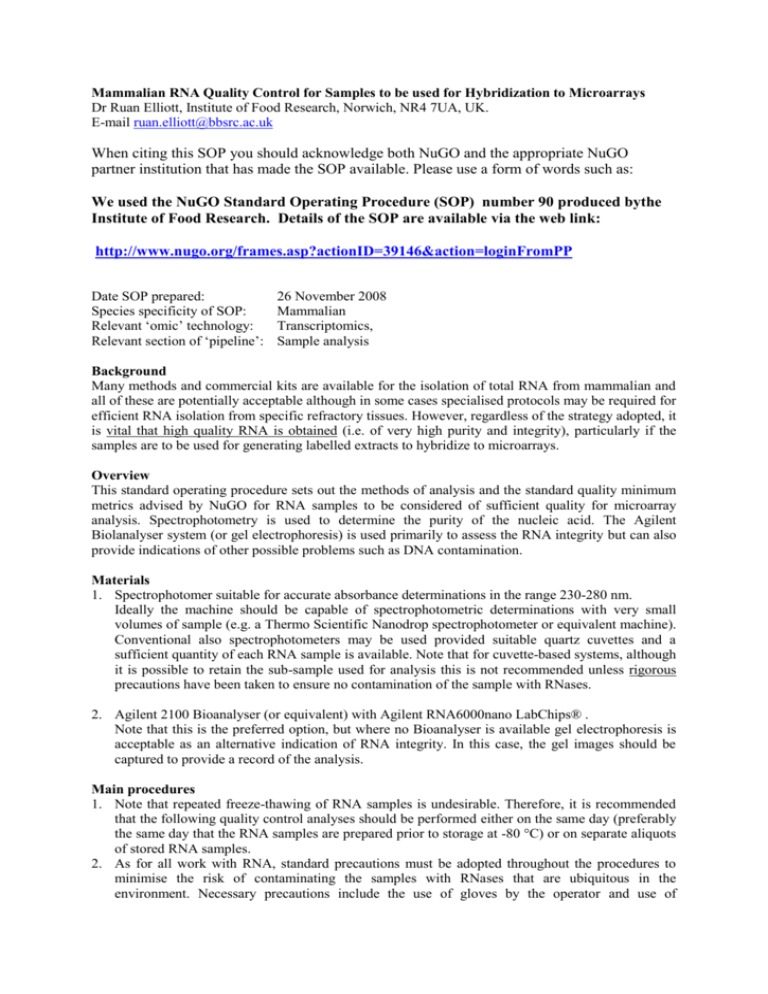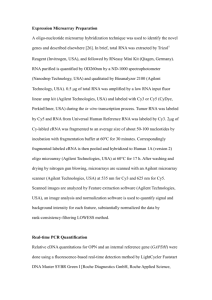Mammalian RNA Quality Control for Samples to be used
advertisement

Mammalian RNA Quality Control for Samples to be used for Hybridization to Microarrays Dr Ruan Elliott, Institute of Food Research, Norwich, NR4 7UA, UK. E-mail ruan.elliott@bbsrc.ac.uk When citing this SOP you should acknowledge both NuGO and the appropriate NuGO partner institution that has made the SOP available. Please use a form of words such as: We used the NuGO Standard Operating Procedure (SOP) number 90 produced bythe Institute of Food Research. Details of the SOP are available via the web link: http://www.nugo.org/frames.asp?actionID=39146&action=loginFromPP Date SOP prepared: Species specificity of SOP: Relevant ‘omic’ technology: Relevant section of ‘pipeline’: 26 November 2008 Mammalian Transcriptomics, Sample analysis Background Many methods and commercial kits are available for the isolation of total RNA from mammalian and all of these are potentially acceptable although in some cases specialised protocols may be required for efficient RNA isolation from specific refractory tissues. However, regardless of the strategy adopted, it is vital that high quality RNA is obtained (i.e. of very high purity and integrity), particularly if the samples are to be used for generating labelled extracts to hybridize to microarrays. Overview This standard operating procedure sets out the methods of analysis and the standard quality minimum metrics advised by NuGO for RNA samples to be considered of sufficient quality for microarray analysis. Spectrophotometry is used to determine the purity of the nucleic acid. The Agilent Biolanalyser system (or gel electrophoresis) is used primarily to assess the RNA integrity but can also provide indications of other possible problems such as DNA contamination. Materials 1. Spectrophotomer suitable for accurate absorbance determinations in the range 230-280 nm. Ideally the machine should be capable of spectrophotometric determinations with very small volumes of sample (e.g. a Thermo Scientific Nanodrop spectrophotometer or equivalent machine). Conventional also spectrophotometers may be used provided suitable quartz cuvettes and a sufficient quantity of each RNA sample is available. Note that for cuvette-based systems, although it is possible to retain the sub-sample used for analysis this is not recommended unless rigorous precautions have been taken to ensure no contamination of the sample with RNases. 2. Agilent 2100 Bioanalyser (or equivalent) with Agilent RNA6000nano LabChips® . Note that this is the preferred option, but where no Bioanalyser is available gel electrophoresis is acceptable as an alternative indication of RNA integrity. In this case, the gel images should be captured to provide a record of the analysis. Main procedures 1. Note that repeated freeze-thawing of RNA samples is undesirable. Therefore, it is recommended that the following quality control analyses should be performed either on the same day (preferably the same day that the RNA samples are prepared prior to storage at -80 °C) or on separate aliquots of stored RNA samples. 2. As for all work with RNA, standard precautions must be adopted throughout the procedures to minimise the risk of contaminating the samples with RNases that are ubiquitous in the environment. Necessary precautions include the use of gloves by the operator and use of guaranteed RNAse-free plasticware (including aerosol resistant RNase-free pipette tips) and RNase-free water (available from many commercial suppliers or by DEPC-treatment of high purity water). 3. Spectrophotometry: the absorbance of all RNA samples should be determined at 230, 260 and 280 nm. The spectrophotometry should be performed according to the instructions of the system manufacturer. 4. Agilent Bioanalyser analysis: aliquots of all RNA samples should processed according the system manufacturer’s standard protocol using Agilent RNA6000nano LabChips®. Safety The procedures all set out above low risk although mammalian RNA should be treated as a potentially biohazardous material. Results analysis The quality of all RNA samples should be determined prior to use with microarrays and the information obtained should be recorded as part of the study metadata. For samples to be considered of suitable quality the following parameters should be met: 1. The ratio of absorbance at 260nm/absorbance at 280 ratio should be within the range >1.8 and <2.2 Low ratios indicate that the sample is likely to be contaminated with protein. Note also that this ratio can be affected by the use of buffers to dilute the sample prior to analysis. 2. The ratio of absorbance at 260nm/absorbance at 230 ratio should be >1.8. Lower ratios typically indicate contamination with organic material such as solvents used in the isolation protocol. 3. The RIN (RNA INtegrity) scores - obtained from the Agilent Bioanalyser should be >8.O. RIN scores range from 1-10 and are derived automicailly by the Agilent software from the sample electropherograms using a proprietary algorithm. A RIN score of 10 indicates completely intact RNA, whereas a RIN score of 1 indicates complete degradation. Note that the values obtained can vary somewhat from organism to organism and tissue to tissue so this should be considered as an advisory cutoff value. It is also important to visually inspect the sample electropherograms and checks of what should be expected for different tissues can be made against Agilent’s RNA integrity database (RINdb available at http://www.chem.agilent.com/rin/_rinsearch.aspx). References http://www.chem.agilent.com/en-US/products/instruments/lab-on-a-chip/2100bioanalyzer/rnasolutions http://www.chem.agilent.com/enus/Search/Library/_layouts/Agilent/PrimaryDocumentViewer.ashx?whid=37507 Schroeder A, Mueller O, Stocker S, Salowsky R, Leiber M, Gassmann M, Lightfoot S, Menzel W, Granzow M and Ragg T. The RIN: an RNA integrity number for assigning integrity values to RNA measurements. BMC Molecular Biology 2006, 7:3





